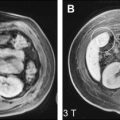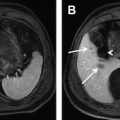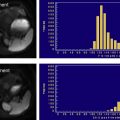Iron overload is the histologic hallmark of hereditary hemochromatosis and transfusional hemosiderosis but also may occur in chronic hepatopathies. This article provides an overview of iron deposition and diseases where liver iron overload is clinically relevant. Next, this article reviews why quantitative noninvasive biomarkers of liver iron would be beneficial. Finally, we describe current state-of-the-art methods for quantifying iron with MR imaging and review remaining challenges and unsolved problems.
This article reviews emerging magnetic resonance imaging (MR imaging) techniques that attempt to quantify liver iron noninvasively. The content is divided into the following sections:
- •
Overview of iron deposition and diseases where liver iron overload is clinically relevant.
- •
Review why quantitative noninvasive biomarkers of liver iron would be beneficial.
- •
Describe current state-of-the-art methods for quantifying iron with MR imaging, including remaining challenges and unsolved problems.
- •
Explore the challenge and new approaches for quantifying iron overload when both iron and fat are present in the liver.
After reading this content, the reader should understand the scope of diffuse liver disease with regard to iron deposition and the limitations of biopsy, and be familiar with emerging quantitative MR imaging methods for measuring liver iron.
Iron metabolism and overload
Hepatic iron overload is the abnormal and excessive intracellular accumulation of iron in hepatocytes, Kupffer cells, or both hepatocytes and Kupffer cells, primarily as ferritin particles and hemosiderin aggregates. Iron overload may occur selectively in the liver but more commonly iron overload is a systemic condition that affects extrahepatic organs as well as liver. In this section, we briefly review normal iron metabolism and the pathogenesis and clinical relevance of iron overload.
Normal Iron Metabolism
An essential nutrient, iron is required by every human cell. Under physiologic conditions, about 10% of dietary iron (1 to 2 mg/d) is absorbed daily, while a similar amount of iron is lost via sloughing of cells from the skin and mucosal surfaces. An additional 2 mg/d is lost in premenopausal women because of menstruation. The intestinal absorption of iron adjusts to physiologic needs and is carefully regulated to balance losses. As a result, iron concentration is normally maintained in a narrow homeostatic range, about 40 mg Fe/kg body weight in women and 50 mg Fe/kg in men. About 80% of body iron is functional, located in hemoglobin in red blood cells, myoglobin in muscle, and in iron-containing enzymes. A small fraction of iron is bound to transferrin, an intravascular transport protein that delivers iron to the liver, bone marrow, and other tissues. About 20% of body iron is in storage form and contained within the storage protein, ferritin, a hollow apoprotein shell with a central cavity, (7–8 nm in diameter, filled with iron oxyhydroxide nanocrystals). In normal mammalian liver tissues, ferritin is found mainly in the cytoplasm of hepatic Kupffer cells as well as spleen and in bone marrow macrophages.
Hepatic Iron Overload
Although the body is capable of regulating intestinal absorption of iron, the body has no mechanism for regulating iron elimination. Thus, increased supply of iron leads to systemic iron overload. If sustained, the overload eventually overwhelms the capacity of ferritin to sequester the excess iron. When ferritin storage capacity is exceeded, free iron accumulates in the cells of the affected organ or organs. Additionally, ferritin molecules cluster in the cystoplasm and inside lysosomes of affected cells. Some of the ferritin denatures to form insoluble aggregates of hemosiderin, nanoscale particles with a relatively broad range of size and shape. Thus, in normal conditions, iron is stored mainly as ferritin molecules in the cytoplasm, but in iron overload states, iron is stored not only as cytoplasmic ferritin molecules but also as cytoplasmic ferritin clusters, lysosomal ferritin clusters, and insoluble hemosiderin aggregates. The functional iron pool is unaffected.
The free intracellular iron reacts with hydrogen and lipid peroxides and generates toxic hydroxyl and lipid radicals that attack cell membranes, cellular proteins, and nucleic acids. The damage, if sustained, leads to progressive fibrosis and organ dysfunction. Clinical manifestations depend on the pattern and severity of organ involvement, which in turn depend on the route and cause of the iron overload.
Iron overload may result from excess intestinal absorption, repeated intravenous blood transfusions, or a combination of the two:
Excess intestinal absorption leads initially to accumulation of iron in periportal hepatocytes and later to hepatocytes throughout the liver lobule. With further progression, iron accumulates in Kupffer cells and biliary epithelium. Eventually, there is spillage of iron into the circulation, where it binds to transferrin. The transferrin delivers the excess iron to organs with high transferrin-receptor density (pancreas, myocardium, thyroids, gonads, hypophysis, skin), leading to iron overload at these sites. Extrahepatic reticuloendothelial organs (spleen, marrow, and lymph nodes) are relatively spared.
Intravenous blood transfusions lead to preferential involvement of the reticuloendothelial system. Red blood cell transfusions provide 200 to 250 mg iron per unit, and the iron contained in the transfused red blood cells accumulates in the reticuloendothelial cells of liver, spleen, bone marrow, and lymph nodes, where it is safely sequestered as ferritin until the storage capacity of the reticuloendothelial system (10 g of iron, or the amount of iron delivered by 40 to 50 transfusions) is saturated. After saturation, the iron accumulates in hepatocytes and in parenchymal cells of the pancreas, myocardium, and endocrine glands.
Conditions associated with hepatic iron overload include hereditary hemochromatosis (HH), thalassemia, sickle cell disease (SCD), sideroblastic anemia, chronic hemolytic anemias, transfusional and parenteral iron overload, dietary iron overload, myelodysplasia, and chronic hepatopathies. In the following sections, we briefly discuss iron overload in HH, thalassemia, SCD, and chronic hepatopathy. In the first 3 conditions, excess iron deposits in an otherwise normal liver and may cause liver disease; in the latter condition, iron deposits in an already abnormal liver and may accelerate disease progression.
Hereditary hemochromatosis
HH is a genetic disorder associated with mutations in genes regulating iron metabolism, the most common of which are in the HFE gene. These gene mutations result in dysregulated constitutive intestinal iron uptake. Affected patients absorb iron at 5 to 10 times the normal rate (up to 10 mg/d), which may lead to total-body iron overload and accumulation of excess iron in liver, heart, and other organs, as discussed previously. Liver iron stores are often more than 10 times that of normal liver. HH is the most common genetic disorder in populations of Northern European ancestry. In the United States, about 6% of persons have a mutation in one of the causative genes. The penetrance of disease is lower, and the prevalence of clinically relevant disease is about 1 in 300 to 400 in Caucasian populations and lower in other racial groups. Complications of HH include liver fibrosis, cirrhosis (5% of patients), arthritis, diabetes, and assorted cardiac disturbances owing to iron deposition in the liver, joints, pancreas, and heart, respectively. These complications are more common in and occur at a younger age in men than women, in whom menstruation helps to check the progression of iron overload. Patients with cirrhosis may develop hepatocellular carcinoma, which is a leading cause of death in these patients. In patients with HH, the severity of hepatic iron overload is an important prognostic biomarker for development of both hepatic and extrahepatic complications.
Thalassemias
These are genetic disorders in hemoglobin synthesis that prevent the body from producing sufficient hemoglobin and red blood cells. Thalassemias are prevalent in people of Mediterranean origin. The prevalence is low in Northern Europe. Chronic blood transfusion is life saving, but the repeated transfusions cause progressive accumulation of iron in the reticuloendothelial system. Patients with thalassemia major and other transfusion-dependent anemias receive roughly 0.4 mg/kg/d of heme iron, 10 to 50 times the physiologic rate of iron absorption. This transfusional overload is exacerbated by increased intestinal iron absorption stimulated by tissue hypoxia, apoptosis of defective erythroid precursors generated by ineffective erythropoiesis, as well as hemolysis of native and transfused red blood cells. Because of the additive iron-loading mechanisms, systemic iron overload becomes severe in infancy or early childhood. Without aggressive iron chelation therapy, affected patients die from endocrine and cardiac dysfunction in the second decade of life. Liver disease caused by hepatic iron overload may cause morbidity and contribute to poor quality of life but, in the absence of concomitant viral hepatitis, death attributable to cirrhosis is rare. The relative rarity of end-stage liver disease in these patients can be attributed in part to premature death from cardiac and endocrine disease and in part to preferential accumulation of iron in Kupffer cells rather than hepatocytes as part of the hepatic involvement.
Sickle cell disease
SCD is a common, genetic blood disorder with high prevalence in African Americans. Although sickle cell disease is associated with anemia, erythropoiesis is virtually normal and so there is no significant increase in intestinal iron absorption. Thus, nontransfused patients with SCD do not spontaneously load iron. Patients with SCD, however, may receive blood transfusions to alleviate symptoms that occur during a sickle crisis and consequently develop transfusional iron overload. SCD also is associated with intravascular (extrasplenic) hemolysis. Free hemoglobin is released from destroyed red blood cells into the blood and filtered by the kidneys; some of the filtered hemoglobin is excreted in the urine but some is reabsorbed by the proximal convoluted tubules and deposits in the renal cortex as ferritin and hemosiderin.
Chronic hepatopathy
Chronic liver diseases (hepatitis B and C virus infection, alcohol-induced liver disease, nonalcoholic fatty liver disease, and porphyria cutanea tarda) are sometimes associated with hepatic iron overload ; this has been attributed to diminished functional hepatocyte mass, aberrant hepatic signaling with excess intestinal iron absorption, and reduced mobilization of storage iron from the liver. In these diseases, the primary liver condition is the paramount abnormality and the secondary iron overload is less important. Emerging evidence suggests, however, that hepatic iron accumulation in patients with preexisting liver disease plays a synergistic role in the development of hepatic fibrosis and cirrhosis, reduces response to antiviral interferon therapy, and contributes to the development of hepatocellular carcinoma (HCC).
Stay updated, free articles. Join our Telegram channel

Full access? Get Clinical Tree






